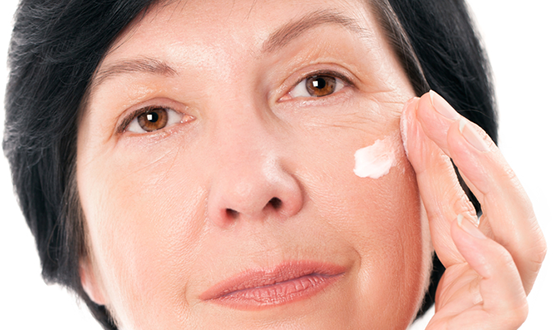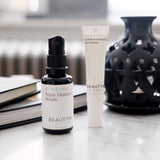
The skin under your eyes is anywhere from seven to 10 times thinner than the rest of your face. This means the undereye area is more vulnerable to puffiness, dark circles (because blood vessels under the skin are easier to see), and wrinkles. While you may apply an undereye cream to keep the skin moisturized, the undereye skin has similar problems to the rest of your face: it collects extra dead skin cells that make your skin appear dull and uneven.
The delicate skin under your eyes is a challenge, however. You need a product to exfoliate the skin to invisibly slough those dead skin cells off. However, most physical exfoliants (like scrubs) and even some chemical exfoliants are too harsh for the undereye area. Facial Glycolic Acid products are not typically formulated for the eyes, but exceptions exist.
When properly buffered and adjusted to the right pH, glycolic eye cream can provide a gentle exfoliating effect that offers beautiful results. Consider these three benefits to using a glycolic eye cream.
One: Restores a Glow to Your Eyes
Don't let the term "acid" stop you -- not all acids are harmful or even overly irritating. Glycolic Acid is derived from sugar cane. The acid can be added in varying concentrations to skincare creams to offer many skincare benefits, one of the most important of which is exfoliation.
Glycolic Acid can restore a "glow" to the undereye area. Accumulated dead cells cause a rough, uneven texture, and rough skin doesn't glow. To understand this, think of a surface of a pool. When the water is calm and wave-free, you can see a more even, glowing reflection of yourself. If the waters are choppy and uneven, light cannot reflect as easily and the reflection is distorted.
When applied to the skin, glycolic acid creates a chemical reaction that loosens the skin's "glue" that holds dead skin cells on the skin's outermost layers. Thus, through regular application of glycolic eye cream, your undereye area can be free of lingering dead skin cells that are affecting your skin's ability to reflect light. Smoother skin results in greater reflection which brings a "glow" to the undereye area. This makes your eyes appear brighter and less tired.
Two: Evens Your Skin's Tone and Texture
Many people have tried every concealer and light-reflecting cream in an attempt to conceal the skin underneath. Applying a glycolic undereye cream can help to solve the real problem, which is uneven tone and texture that can cause your undereye area to appear puffy, dark, and wrinkled.
While glycolic acid may not be able to reverse your genetic makeup, it can be a skincare ingredient that offers benefits that extend beyond moisturizing. For example, the BeautyRx Gentle Exfoliating Eye Therapy Cream contains glycolic acid that's combined with anti-inflammatory compounds such as the proprietary REGU��-AGE, Japanese Green Tea Leaf Extract, Lavender Extract, and Lemon Fruit Extract. Each plays a part in working with glycolic acid to improve skin's tone and texture.
Three: Firms the Undereye Area
Further proof that glycolic acid is a hard-working ingredient is its benefits in increasing the production of skin-firming collagen and hyaluronic acids. Because skin thinning is linked with increased presence of wrinkles, increased skin volume causes the undereye skin to appear younger.
Getting Results With Glycolic Eye Cream
Two key factors exist to realizing the full benefits of glycolic for the undereye area. One, you have to have the right formulation made specifically for the eyes. The BeautyRx Gentle Exfoliating Eye Therapy Cream contains a lower percentage of glycolic acid than facial glycolic acid products because it is specially formulated at a level effective enough to work on the undereye area.
The second key factor is frequent and routine application in the morning and evening. Consistent application allows glycolic eye cream to accomplish its jobs of creating smoother, more glowing undereye skin.
References:
Burgess, C. (ed.). (2005). Cosmetic Dermatology. Springer.
How to create an anti-aging skin care plan. (n.d.). American Academy of Dermatology. Retrieved from https://www.aad.org/dermatology-a-to-z/health-and-beauty/every-stage-of-...
Schultz, N. (2009, July 8). How to Eliminate Under Eye Dark Circles. Retrieved from http://www.dermtv.com/how-eliminate-under-eye-dark-circles
Thomas, R. & T. Dixon, T. Bhattacharyya. (February 2013). Effects of topicals on the aging skin process. Facial Skin: Contemporary Topics for the Surgeon. Elsevier.
 BRX REWARDS
BRX REWARDS






















Leave a Comment